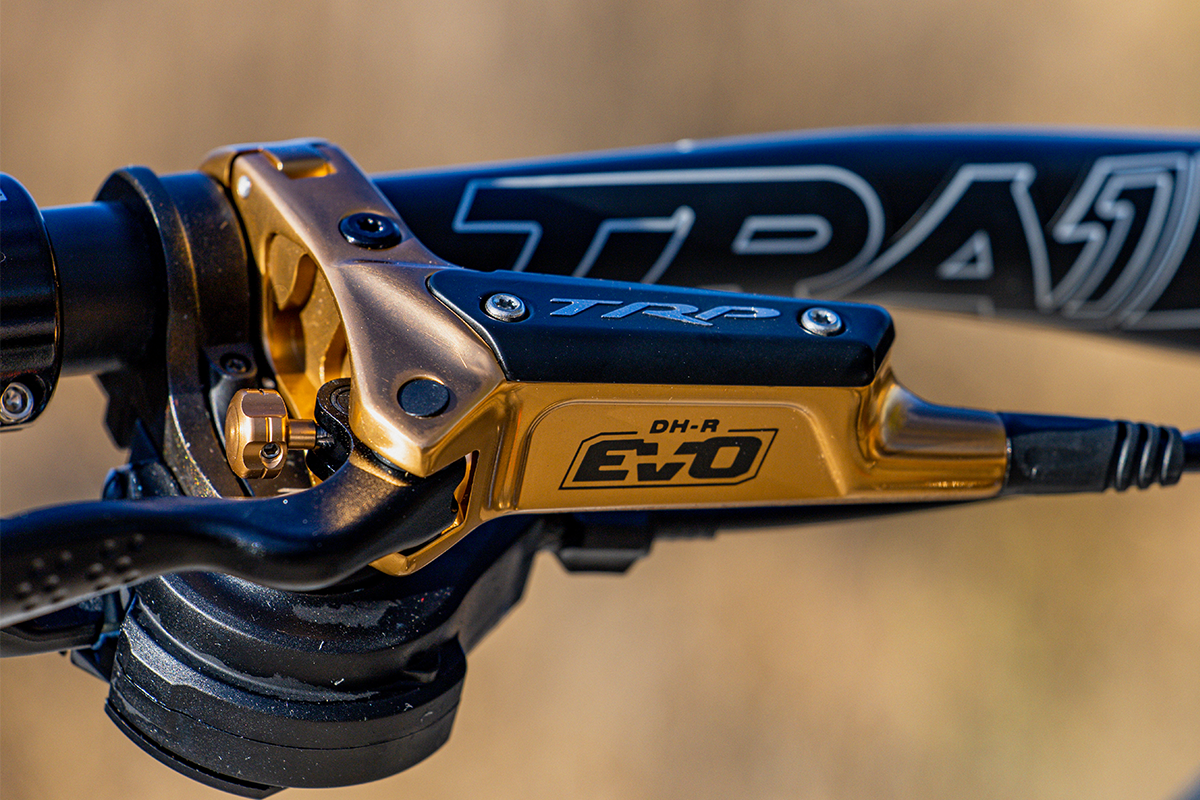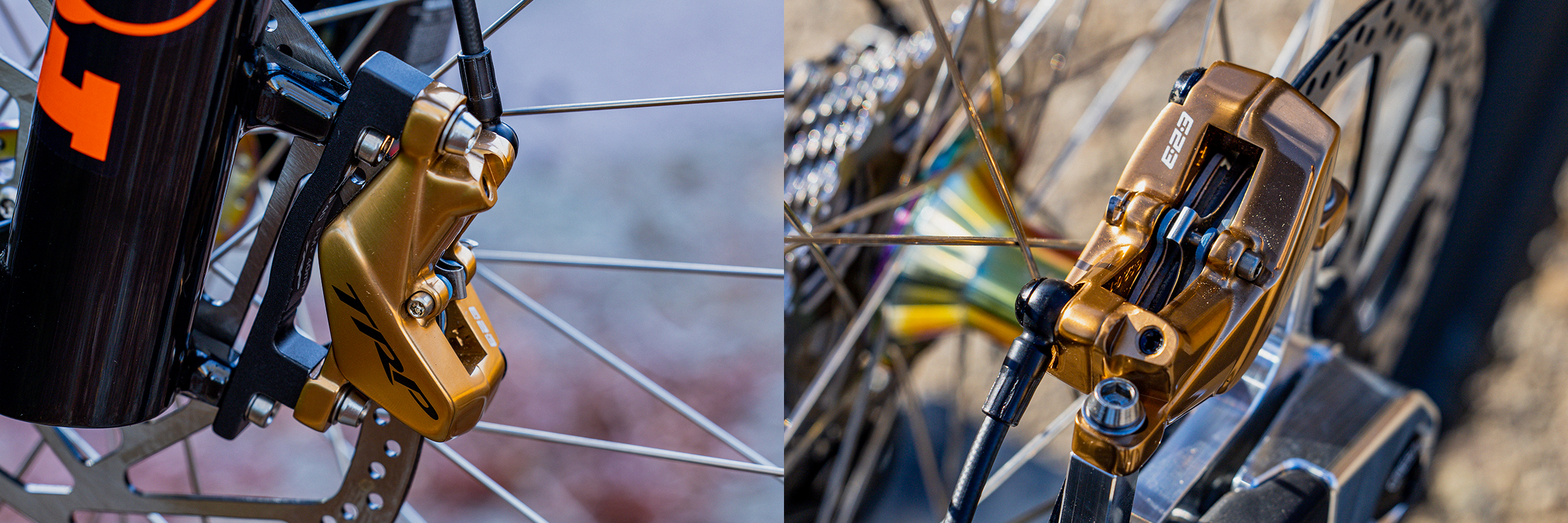- Continue Shopping
- Your Cart is Empty
TRP DH-R EVO Brakes - Powerful With Modulation
What Happens When TRP Makes Brakes For Some Of The Best MTBr’s In The World?
Words By: Zach Waymire
When a company takes some of the fastest World Cup racers like Aaron Gwin, Neko Mulally and Brandon Fairclough to make a brake that satisfies their demands for a powerful brake, something spectacutre comes out of it. TRP has been really making progress over the past few years, starting with the Quadiem and continually making improvements since that brake. Now the latest downhill worthy brake from TRP are the new TRP DH-R EVO Brakes, a 4 piston brake designed to deliver tons of power while also having modulation and reliability, seems to good to be true right? After hearing about the hype on the brakes, I had to throw them on my Deviate 150 Highlander to see if they hold up to the claims.
Out of the box:
The first thing I noticed was the construction of the lever and caliper. The machining and polish are very impressive and fun to stare at if you’re into that type of stuff. Taking a closer look at the caliper’s pistons, the make-up of the pistons seems to be more sound than the typical plastic pistons that the competitors are using. The calipers use a stainless steel shim around a composite piston. When holding the caliper and lever in hand, the heft gives you a sense of quality and power. There’s no doubt they’re not made to be the lightest brake in the game, but that’s not what they were made for.
Specs:
- Ergonomic lever blade
- 9mm internal brake lever piston
- Index Reach adjuster
- I-spec II compatible
- MMX/TRP Shifter/I-Spec EV Compatible
- Performance Fluid Design
- Lightweight hybrid pistons
- Top loading pad design
- New resin brake pad
- New mineral oil
- 5mm brake hose
- CNC-machined and marked adapters
- Banjo design
- Lever and caliper weight: 310g (Front without rotor and adapter)
- 4-Piston Caliper
- Intended Rotor Thickness: 2.3 mm
Performance:
As someone that focuses mainly on the descents and being In the Reno/Tahoe area where the Sierra Nevada Mountains are in our backyard. Our trails range from fast and flowy to butt-on-tire steep, I strongly prefer powerful brakes to keep up with the terrain and conditions. So after the claims that TRP was making about the DH-R EVO and reading other reviews, I was very interested to get my hands on a set.
Installing the brakes is simple, just like installing any other brakes with olive and barb, but you’ll have to make sure you use TRP’s Olive and Barb system (TRP provides extras in the box). Bleeding them is somewhat as simple as bleeding Shimano Brakes. It does take more patience and time, we noticed that it’s better to put a full bleed on the brakes by pushing the fluid from the caliper up to the lever into a bleed cup. We tried just putting a top bleed after installing the brakes like some typically do with Shimano’s brakes, but we noticed that the lever feel isn’t as good as it would be with a full bleed. After putting a full bleed on the brakes, we would keep the bleed cup on the levers and use either a strap or rubber bands to hold the brake lever closed for a couple of hours or even overnight. This helps bring any air bubbles to the top of the system and clear them out from the line or caliper.
Also when installing the brakes, I went straight into using the sintered pads rather than using the organic brakes. It took some time to bed in the pads. The sintered pads were a little laggy in the beginning to get heated for corners. When there was a high-speed section into a tight corner and I knew I really needed to shut it down, I would tap the brakes early and then fully lay into them. But over time the rotors fully bedded in and the pads bite almost instantly. After some time on the sintered pads, I decided to throw on the organic pads. I quickly realized the organics bite hard at the beginning which is nice when riding through wetter terrain. The organics I did notice will fade much quicker than the sintered when things got really hot. If the conditions were typically cold and wet, I would prefer the organics, but in my local terrain I decided to put the sintered pads back in.
Comparing the DH-R EVOs to the big names such as Shimano and SRAM’s brakes. I would say the TRP’s are extremely powerful, they have the initial bite similar to Shimano Saints and similar power to the SRAM Code RSC once in the power band, but the SRAMs seems to fade more and Saints are more on/off than the DH-R EVO’s.
On the trail, the brake lever feel in my opinion is a little more like SRAM in the sense that there isn’t an “On-Off” feel but, the DH-R EVOs have a more solid wall than SRAM. When the lever hits the wall I noticed the modulation was very similar to Shimano because a little input would go a long way.
With power, I’m very impressed with the brakes actually. I’m one that loves the power of Saint brakes and when the DH-R EVOs are set up correctly, I would say they have more power than the infamous Saint brakes. It was a learning curve figuring out the modulation on the brakes, there is quite a bit of modulation. Once the lever hits the wall, the bite is very powerful and the modulation pull gets finer. Coming off of the SRAM Code RSC there were a couple of times where I locked up the front end, unintentionally because of being used to pulling harder to get the same power. After I got used to the power, I noticed that the arm pump and hand fatigue went away due to not gripping hard and pulling hard on the brakes.
Although the brake doesn’t have that many adjustments like the Code RSCs do, the power of the brakes is so impressive that the reach adjustment on the DH-R EVOs is enough. Although it would be interesting to see the brakes with a contact point adjustment. The ergonomics of the lever blade on the DH-R EVOs are my favorite of all of the brakes I’ve tried. I like to brake with my index finger like most people and I like to have my finger on the hook of the brake. The hook portion of the lever is deeper than most brakes so I find my finger sits very comfortably and hardly moves around when the trails get chunky.
Pros/Cons
Pros:
- Impressive power
- Great modulation
- Construction of lever and caliper is solid
- Easy to work on
- Ergonomic lever
Con’s:
- Not a lot of adjustability
- Full bleeding the brakes can be a little messy due to where the bleed port is.
What is Worldwide’s Thoughts?
TRP isnt new to the brake market and after a few iterations of their 4 piston brakes, the new TRP DH-R EVO brakes are their best yet. On the bikes of riders like Aaron Gwin, Neko Mullaly, Amaury Pierron, Myriam Nicole, Brandon Fairclough and more, you know they are powerful and reliable to be ridden by that insane list of riders. Who are these brakes for? These brakes are for someone that wants the most power out of their brakes, they are not the lightest, but man do they deliver the power you want. These brakes are make a big splash in the enduro/DH market for a good reason, they are amazing!












